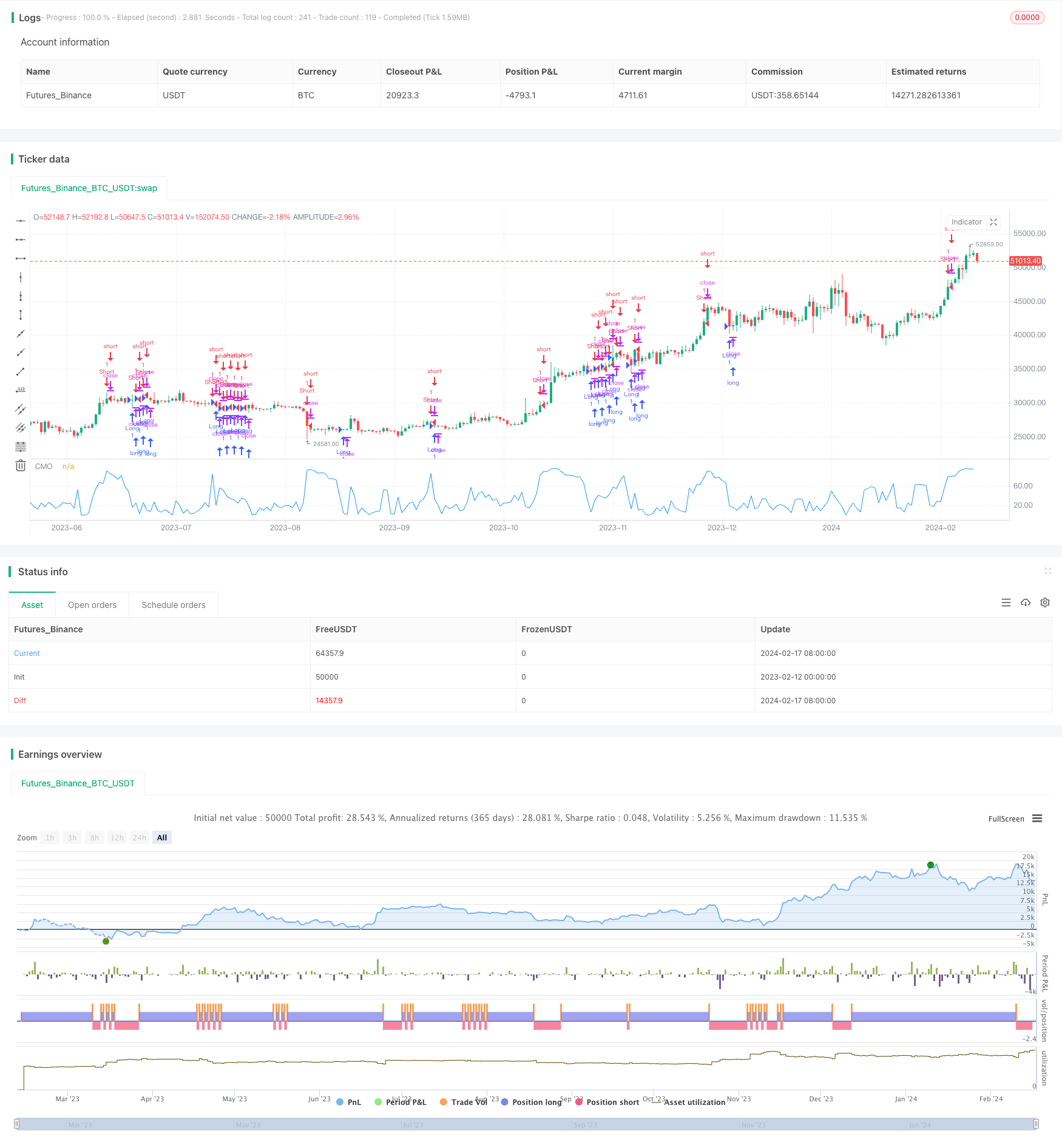
概述
动量绝对值指标策略是基于Tushar Chande开发的动量指标CMO的改进版本。该策略通过计算价格的绝对动量值,判断市场目前是否处于超买或超卖状态,以捕捉市场中期的价格波动。
策略原理
该策略的核心指标是经过改进的CMO指标,称为AbsCMO。AbsCMO的计算公式为:
AbsCMO = abs(100 * (最新收盘价 - Length周期前的收盘价) / (Length周期内价格波动绝对值的简单移动平均 * Length))
其中,Length代表平均期间长度。AbsCMO值区间为0至100。该指标结合了动量方向性和强度 monumentality,能清晰判断市场中期趋势和超买超卖区域。
当AbsCMO上穿指定的上轨(默认70)时,表示市场步入超买,做空;当AbsCMO下穿指定的下轨(默认20)时,表示市场步入超卖,做多。
优势分析
与其他动量指标相比,AbsCMO指标具有如下优势:
- 反映价格绝对动量,判断市场中期趋势更加准确;
- 结合方向性和强度,识别超买超卖更为明确;
- 限定范围在0-100,更适合多个品种之间比较;
- 对于短期剧烈波动不敏感,反应市场中期趋势;
- 可自定义参数,适应性强。
风险分析
该策略主要存在以下风险:
- 中期指标,对短期波动反应不够灵敏;
- 默认参数可能不适合全部品种,需要优化;
- 长期持仓可能带来较大的回撤。
可以通过适当缩短持仓周期,优化参数,或与其他指标组合使用来减少风险。
优化方向
该策略可从以下几个方面进行优化:
- 优化AbsCMO的参数,适应更多品种;
- 结合其他指标过滤假信号;
- 制定止损和止盈规则,控制风险;
- 结合深度学习等技术寻找更佳入场点。
总结
动量绝对值指标策略整体来说是一个比较实用的中期交易策略。它反应价格中期绝对动量特性,判断市场中期趋势的判断力较强。但该策略对短期剧烈波动不敏感,存在一定的风险。通过参数优化、指标过滤、止损机制等进一步完善,可以使该策略的实盘表现更加稳定可靠。
策略源码
/*backtest
start: 2023-02-12 00:00:00
end: 2024-02-18 00:00:00
period: 1d
basePeriod: 1h
exchanges: [{"eid":"Futures_Binance","currency":"BTC_USDT"}]
*/
//@version=2
////////////////////////////////////////////////////////////
// Copyright by HPotter v1.0 17/02/2017
// This indicator plots the absolute value of CMO. CMO was developed by Tushar
// Chande. A scientist, an inventor, and a respected trading system developer,
// Mr. Chande developed the CMO to capture what he calls "pure momentum". For
// more definitive information on the CMO and other indicators we recommend the
// book The New Technical Trader by Tushar Chande and Stanley Kroll.
// The CMO is closely related to, yet unique from, other momentum oriented indicators
// such as Relative Strength Index, Stochastic, Rate-of-Change, etc. It is most closely
// related to Welles Wilder`s RSI, yet it differs in several ways:
// - It uses data for both up days and down days in the numerator, thereby directly
// measuring momentum;
// - The calculations are applied on unsmoothed data. Therefore, short-term extreme
// movements in price are not hidden. Once calculated, smoothing can be applied to
// the CMO, if desired;
// - The scale is bounded between +100 and -100, thereby allowing you to clearly see
// changes in net momentum using the 0 level. The bounded scale also allows you to
// conveniently compare values across different securities.
//
// You can change long to short in the Input Settings
// Please, use it only for learning or paper trading. Do not for real trading.
////////////////////////////////////////////////////////////
strategy(title="CMOabs", shorttitle="CMOabs")
Length = input(9, minval=1)
TopBand = input(70, minval=1)
LowBand = input(20, minval=0)
reverse = input(false, title="Trade reverse")
// hline(0, color=gray, linestyle=dashed)
// hline(TopBand, color=red, linestyle=line)
// hline(LowBand, color=green, linestyle=line)
xMom = abs(close - close[1])
xSMA_mom = sma(xMom, Length)
xMomLength = close - close[Length]
nRes = abs(100 * (xMomLength / (xSMA_mom * Length)))
pos = iff(nRes > TopBand, -1,
iff(nRes < LowBand, 1, nz(pos[1], 0)))
possig = iff(reverse and pos == 1, -1,
iff(reverse and pos == -1, 1, pos))
if (possig == 1)
strategy.entry("Long", strategy.long)
if (possig == -1)
strategy.entry("Short", strategy.short)
barcolor(possig == -1 ? red: possig == 1 ? green : blue )
plot(nRes, color=blue, title="CMO")